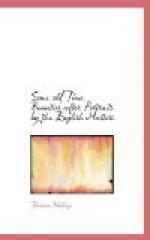were handsome. Of all the portraits of Miss Linley,
perhaps the one by Gainsborough, in which she is portrayed
with her young brother, gives the best idea of the
special character of her type of beauty. Here
are the large lustrous eyes and the very delicately
modelled, sensitive, refined features; here, the luxuriant
hair, the slender neck, and the sloping shoulders;
and here, the superb poise of head and of mind.
There is another fine picture of her by Gainsborough,
for this painter was one of the brilliant men who
frequented her father’s house at Bath. A
musician he was, too, and an excellent performer on
the violin, so was congenial company in that musical
family. He admired the daughter, and wrought for
us the delightful records of her beauty. His
change of residence, from Bath to London, coincided
in date with that of the Sheridans. Opie, too,
painted her portrait; not an ideal one, but good in
respect to her eyes. And Romney has given us
good pictures both of her and Mrs. Tickell. Reynolds’s
portrayal is supreme in indicating the exaltation
of spirit, by the poise of head and perfection of profile.
This picture of her as the patron saint of song was
exhibited at the Academy, in 1775, just about the
time its subject had abandoned public singing.
It has been most beautifully engraved by Bartolozzi,
and ranks as one of his best plates. When the
days of sorrow came to Sheridan,—when his
weaknesses of character brought him to a low estate;
when poverty became his portion, and the long lost
days of romantic love became but a memory; when treasure
after treasure, manuscripts, and sumptuous books were
disposed of, and presentation pictures were pawned,—this
picture of St. Caecilia, a reminder of the days that
had vanished, was the last valued possession to be
parted with.
[Illustration: Marguerite Countess
of Blessington by Lawrence]
LADY BLESSINGTON
The brilliant Blessington,—brilliant in
beauty and in intellect! Throughout her life
of romance she was fortunate in her literary friendships,
through whom a knowledge of her abilities has grown
to tradition, but most fortunate in the portrayer
of her beauty. Lawrence has painted a picture
which it is a perpetual pleasure to behold,—the
superb arms and shoulders, the serene, steadfast gaze
of the eyes, and the conscious, yet confident, poise
of the head forming a record to justify the tradition
of great personal beauty and alertness of mind.
Marguerite Blessington’s youth was ill-regulated
and penurious. She was born in 1789, the second
daughter of Edmund Power, of Knockbrit, near Clonmel,
in the county of Tipperary. Her father came of
a good family, as did also her mother, who spoke unduly
often of her ancestors, the Desmonds. Marguerite
was not comely in her early girlhood, though her sister
Ellen and her brother Robert were handsome children.
As a child, she was sensitive and sentimental, and




